|
|
|
|
Products mentioned in this Article
--None--
|
|
|
|
|
|
|
|
|
 |
|
|
 |
Ia Drang Colour Guide
We take a look a what colours to use when painting your forces for the Battle of Ia Drang. |
Painting Helicopters
Slicks
Bell UH1 ‘Huey’ helicopter is synonymous with the Vietnam War, and the equally distinctive measured ‘thwop thwop’ of its rotors is known to anyone that has been to a war movie about the period. The US Army flew two main variants in 1965. The UH-1B ‘Hog’ gunship and the UH-1D ‘Slick’. |
| The UH-1D was known as a ‘Slick’ because, compared to the gunships, it had a clean appearance. It was called a ‘Dog ship’ by the pilots for the phonetic code D for Dog. While the UH‑1D could carry up to twelve troops under ideal conditions, in the ‘hot and high’ conditions of the Vietnamese highlands the normal load was just eight soldiers and their equipment. |
| Right: It is a good idea to paint the door gunners before gluing them in place. Paint the interior a medium grey – eg. Bunker Grey (FWP304). |
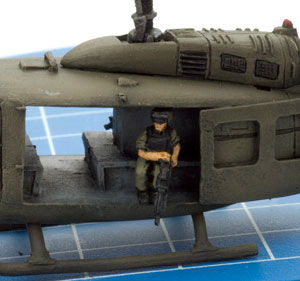 |
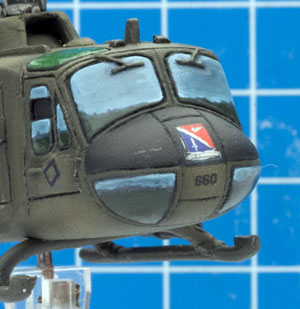 |
Left: Painting a suggestion of reflected landscape in the windows looks good, but try to be subtle, using muted colours. If you don’t want to paint reflections, a flat neutral colour such as Luftwaffe Blue (FWP401) is also effective. Finish with a coat of gloss varnish. |
| Right: Carefully apply the rotor markings in several thin, even coats. Make sure the number on the nose matches the last three digits of the serial number on the tail. |
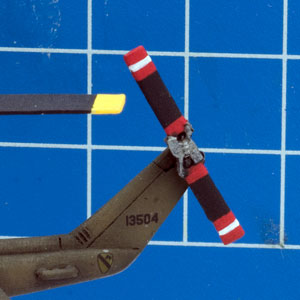 |
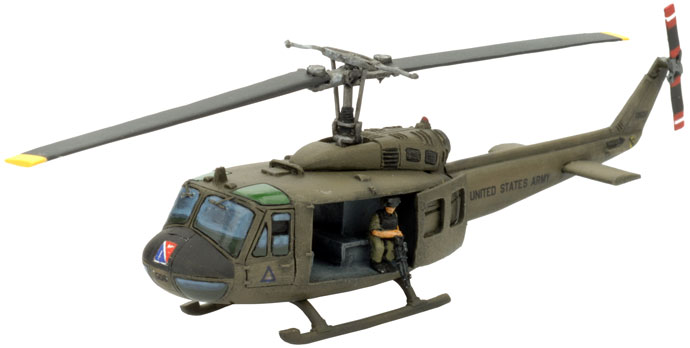 |
Hogs
The older UH-1B helicopters were converted to gunships when the more powerful UH-1D arrived. The UH-1B was nicknamed ‘Hog’ because it handled like a pig when fully armed with rockets and machine guns. While the Slicks could cruise at 110 knots (203km/h), the Hogs could only make 80 knots (148km/h)! The Slicks had to loiter around while the Hogs caught up and prepped the LZ before they could land. The Hogs are equipped with the M22 armament system. This comprises an M134 six-barrelled minigun mounted in traversable mountings on each side and two XM157 rocket pods with seven 2.75” FFAR folding-fin rockets each. |
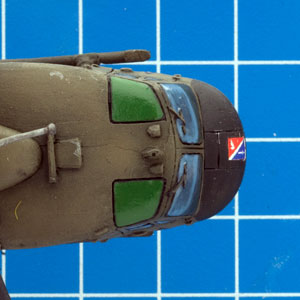 |
Left: The upper windows were tinted green to minimise heat and glare. Paint them a medium green – eg. Splinter Green (FWP343), followed by a coat of gloss varnish. |
| Right: The Hog’s ammunition belts are fiddly to position. Taking your time, carefully twist them into shape before gluing them in place. |
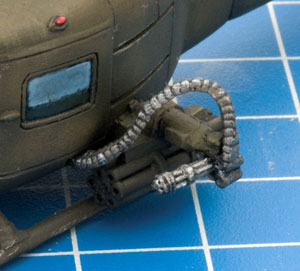 |
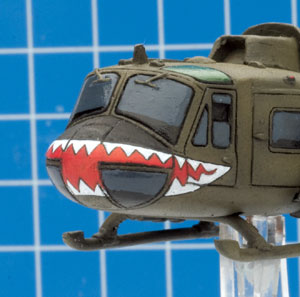 |
Left: If you find the shark’s teeth decal difficult to apply in one piece, you may want to cut it into pieces. Let each piece dry before applying the next, and use a little paint to cover up any visible joins. |
| Right: Huey Decal Sheet. |
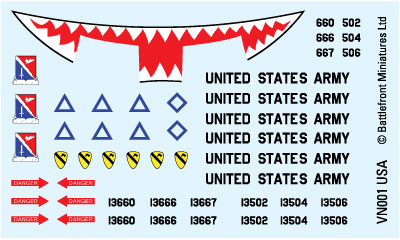 |
At the time of Ia Drang, the Air Cav troopers would still have been wearing black leather combat boots, rather than the lightweight canvas-topped jungle boots which later proved more suitable for a tropical environment.
The Mitchell pattern camouflage helmet cover was reversible, but it was commonly worn green side out at all times, regardless of the terrain. |
 |
The standard field uniform of the PAVN was a simple loose-fitting design. From 1966 the standard colour was a darkish green, but the troops at Ia Drang would still have been outfitted in a faded tan colour. Footwear consisted of a simple canvas ‘jungle shoe’ with a black rubber sole and toe cap. These came in tan, green and sometimes black. The distinctive sun helmet was a similar colour to the rest of the uniform, while the soft bush hat came in a variety of colours ranging from brown to Army Green.
Uniform items faded heavily with use and were not replaced until they wore out. One way of representing this is by painting the shirt or trousers of some figures a slightly lighter or darker colour. |
Last Updated On Thursday, July 13, 2023
|
|
|